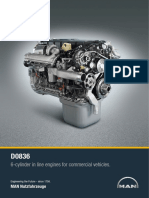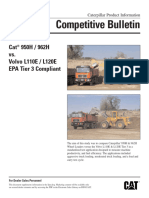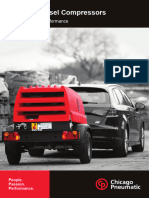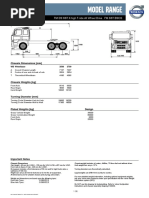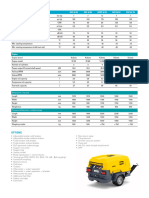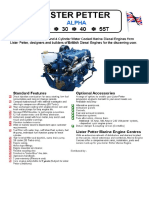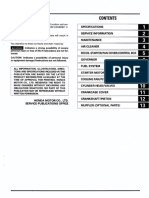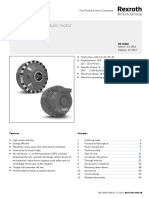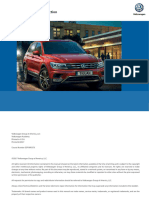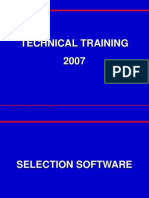Competitive Bulletin: Cat 950H / 962H vs. Volvo L110E / L120E Stage IIIA Compliant
Competitive Bulletin: Cat 950H / 962H vs. Volvo L110E / L120E Stage IIIA Compliant
Uploaded by
DAnielCopyright:
Available Formats
Competitive Bulletin: Cat 950H / 962H vs. Volvo L110E / L120E Stage IIIA Compliant
Competitive Bulletin: Cat 950H / 962H vs. Volvo L110E / L120E Stage IIIA Compliant
Uploaded by
DAnielOriginal Title
Copyright
Available Formats
Share this document
Did you find this document useful?
Is this content inappropriate?
Copyright:
Available Formats
Competitive Bulletin: Cat 950H / 962H vs. Volvo L110E / L120E Stage IIIA Compliant
Competitive Bulletin: Cat 950H / 962H vs. Volvo L110E / L120E Stage IIIA Compliant
Uploaded by
DAnielCopyright:
Available Formats
Caterpillar Product Information
Competitive Bulletin
December 2006
Cat® 950H / 962H
vs.
Volvo L110E / L120E
Stage IIIA Compliant
The aim of this study was to compare Caterpillar's 950H & 962H
versus the Volvo L110E & L120E Stage IIIA in a standardized test
application designed to measure machine productivity, and fuel
efficiency. The applications included aggressive truck loading,
moderated truck loading, and a load and carry test cycle.
For Dealer Sales Personnel
This document supplements information in the Specalog. Marketing content will be available only
on secured dealer extranets and by accessing the PDF in the EAME SalesLibrary on FlashNet.
Specifications
CAT 950H CAT 962H VOLVO L110E VOLVO L120E
Engine Type C7 C7 D7E LB E3 D7E LA E3
Gross Power kW (hp) 161 (219) 172 (234) 170 (231) 180 (245)
rpm 1800 1800 1700 1700
Net Power – ISO 9249 kW (hp) 147 (200) 158 (215) 169 (230) 179(243)
rpm 1800 1800 1700 1700
Net Peak Torque Nm 907 907 1059 1059
rpm 1400 1400 1500 1500
Engine Displacement liters 7.2 7.2 7.1 7.1
Numbers of Cylinders 6 6 6 6
Transmission - Auto Shift Planetary Planetary Countershaft Countershaft
4th Gear Forward Km/h 40 40 36.2 35.1
Hydraulic Cycle Time seconds 11.1 11.1 10.0 10.0
Tires XHA L3 XHA L3 XHA L3 XHA L3
Steering System Load sensing Load sensing Load sensing Load sensing
Sound Level in Cab dB (A) 69 69 68 68
Sound Level External dB (A) 106 106 106 106
Bucket used for Spec
Comparison m3 3.3 3.3 3.3 3.3
Operating Weight kg 18452 19622 18240 19060
Breakout Force kN 158 158 153 162
Straight Static
Tipping Load kg 13007 13681 12900 14080
Full Turn Static
Tipping Load kg 11410 11914 11070 11670
Dump Clearance mm 2835 2896 2860 2930
Reach @ full lift and
45 degree discharge mm 1158 1207 1130 1130
The table below shows Volvo gross power increase of 10% over Cat from Stage II to Stage IIIA
Model 950H 962H L110E II L110E IIIA L120E II L120E IIIA
Engine C7 C7 D7D LB E2 D7E LB IIIA D7D LA E2 D7E LA IIIA
Gross Power hp 219 234 210 231 224 245
Gross Power kW 161 172 155 170 165 180
Net Power kW 200 215 209 230 223 243
Net Power hp 147 158 154 169 164 179
2 Competitive Bulletin Cat 950H / 962H vs. Volvo L110E / L120E
Job Description
The job study was performed at the Quadrifolio Quarry, located in Bergamo, Italy together with the CGT dealership.
The material used was made up of sand and rocks, with a density of approximately 2000 kg/m3. Ambient temperatures
ranged from approximately 25-30 degrees.
Both Cat machines, 950H & 962H used in this study are Stage IIIA compliant, equipped with
Michelin XHA L3 tires, and a 3.3 m3 Universal bucket with teeth. Other options included CCS
(Command Control Steering), Autodig and Ride control. Both Volvo machines, L110E & L120E
are Stage IIIA compliant and were also delivered with Michelin XHA L3 tires and a 3.3 m3
4.5 4.5 General purpose bucket with teeth. Other options included Stick Steer and Rear camera.
3 3
The tire pressure on the machines has been set up the same on all machines before starting the
productivity tests at 4.5 bars on the front and 3 bars on the rear.
The new 950H & 962H are equipped with the Stage IIIA compliant ACERT C7 engine with 7.2
liters displacement, and features multiple other improvements, including a new Caterpillar Load-Sensing Hydraulic
system designed to improve performance and efficiency. The L110E & L120E features a new 7.1 liters displacement
Stage IIIA compliant engine, with Volvo’s V-ACT internal exhaust gas recirculation technology. A major change seen
on the new Stage IIIA Volvo machines is the reverse air flow from the back to the side, doing the same as Cat.
For loading operations, three on-highway trucks of 20t were used. These trucks were 3 pass loaded, and weighed on
mobile scales at the quarry site. Fuel measurements were taken using external fuel tanks fitted on the machines and
equipped with supply and return ports. In line on/off valves were used to switch the fuel supply from the main machine
tank to the auxiliary test tanks. The tanks were filled and weighed before and after each individual test segment to
determine fuel consumption. All cycle times were recorded using a computerized software and splitting the travel time
empty, loading time, travel time loaded and dumping time. All results presented in this study are in metric tons.
Fuel Scale
Test Area
20 Tonnes On-Highway Trucks Material Density: 2t/m³
Competitive Bulletin Cat 950H / 962H vs. Volvo L110E / L120E 3
Job Description
Truck Scale
Cat Universal Bucket 3.3m³ with teeth Volvo General Purpose Bucket 3.3m³ with teeth
4 Competitive Bulletin Cat 950H / 962H vs. Volvo L110E / L120E
Aggressive Truck Loading
2nd Gear with 1st Gear Bucket Loading, 20 Sec Average Cycle Time
The aggressive truck loading cycle is designed to reflect
maximum machine production per hour with and average
cycle time of 20-22 sec. It consists to drive the machine in a
"tight V" shape when loading the trucks. Typical operators
would have a difficult time maintaining this cycle for an
entire shift, but could equal or approach this pace during
peak quarry truck loading periods.
In this study, the operator was asked to run the machines at
the quickest pace at which he felt comfortable but keeping
the 20 sec average cycle time.
Three trucks were placed at the base of the material pile and
were three-pass loaded for a total of 18 trucks. After loading
three trucks, the operators were asked to wait for 1 minute
while the three trucks were coming back to their initial
position. On the Cat machine, the parking brake was actuated so that the low idle was activated after 10 sec going
down to 600 rpm. This unique function really saves fuel while the machines are waiting for the trucks.
Machines were tested with demand fan systems operating, Variable Shift Control set to the “ aggressive” position, ride
control off, and neutralizer function on for the Cat machines.
950H / L110E:
In the aggressive truck loading application, the 950H shows similar productivity numbers and a significant reduction in
fuel consumption, burning 28 liters/hour which represents an advantage of 16% over the 33 liters/hour of the Volvo
L110E. With the combination of a better production and less fuel consumption, the 950H is well positioned in terms
of fuel efficiency showing an advantage of 20%.
With the improvement of the breakout force and the lifting force on the H series, we can see a real advantage when
loading the bucket, resulting in a 14% faster cycle time, which represents 3.3 seconds faster. The 950H’s ability to
maintain engine speed during directional shifts and simultaneous lift and tilt capability helped make it quick during all
the cycle.
962H / L120E:
In this application , the 962H machine shows outstanding numbers in terms of productivity and fuel consumption,
resulting a great fuel efficiency factor of 18 % better than Volvo. Through key feature changes on the 962H, the
machine stability has improved and that translates into faster digging & traveling cycle times. The higher horse power
and rimpull also permitted to penetrate better in the pile resulting a higher productivity.
The control throttle shifting for the L120E during directional shifts made it more difficult for the operator to maintain
smooth hydraulic motion while approaching the truck. Tilt over lift hydraulic priority also slowed the L120E and
lengthened its cycle times. The smoother, and quicker overall cycle time of the 962H helped it to demonstrate the best
productivity, producing material at the rate of 957 tons/hour. This was 11% better than the 860 tons/hour produced by
the L120E. In terms of fuel consumption, the 962H was burning 29.8 liters/hour vs the 31.7 of the L120E, which
represents a 6% in fuel advantage for the 962H.
Volvo presented a better bucket fill factor of 110% vs. 100% but with Cat machine 16% faster cycle times, Cat offsets
Volvo bucket fill factor and produces more per hour. Volvo gross power increase from Tier II to Tier IIIA of 10%
helped in for Volvo's productivity and digability but at the expense of fuel consumption.
CAT great stability would permit the machine to operate with a larger bucket size than Volvo as the 3.3 m3 was at
Volvo’s static tipping load limit.
Competitive Bulletin Cat 950H / 962H vs. Volvo L110E / L120E 5
950H Aggressive Truck Loading
Productivity
P roductivity ( T / hr)
950H L110E
1000
Productivity
900
Tonne/hr 848 835
800
950H Advantage 2%
700
600
848 835 Fuel Consumption
500 Economy (L/hr) 28.1 33.2
400 950H Advantage 16%
300
Fuel Efficiency
200
Efficiency (Tonne/L) 30.2 25.1
100
950H Advantage 20%
0
950H L 110E
Cycle Time
Fuel Consumption
Seconds 19.6 22.9
F u el Co n su mp tio n ( L / h r )
3 5 .0
950H Advantage 14%
3 0 .0
2 5 .0
2 8 .1 3 3 .2
2 0 .0
CAT AD VA NTA GE
+/- 3%
Bad for Cat Good for Cat
15 .0
Difference
Important Note: Any results within 3% for
10 .0 productivity (tons/hr) and fuel efficiency
(tons/liter) are considered equal within the
5 .0 accuracy
0 .0
950H L1 1 0 E
Fuel Efficiency
Fu el Efficien cy ( T / L)
4 0 .0
Cycle Times
3 5 .0
25
3 0 .0
3.64
20
2 5 .0 3.18
Time (Seconds)
6.77
15
2 0 .0 6.19
10
1 5 .0 30.2 25.1 6.80
5.30
5
1 0 .0
4.96 5.72
0
5 .0
950H L110E
Travel Empty Load Travel Loaded Dump
0 .0
950H L 110E
6 Competitive Bulletin Cat 950H / 962H vs. Volvo L110E / L120E
962H Aggressive Truck Loading
962H L120E Productivity
Productivity 1000
Pro d u ctiv ity ( T / h r)
Tonne/hr 957 860 900
962H Advantage 11% 800
700
Fuel Consumption 957 860
600
Economy (L/hr) 29.8 31.7
500
962H Advantage 6%
400
Fuel Efficiency 300
Efficiency (Tonne/L) 32.1 27.2 200
962H Advantage 18% 100
0
Cycle Times 962H L 120E
Seconds 18.9 22.6 Fuel Consumption
962H Advantage 16% F u el Co n su mp tio n ( L / h r )
3 5 .0
3 0 .0
2 5 .0
2 8 .1 3 3 .2
CAT AD VA NTA GE 2 0 .0
+/- 3%
Bad for Cat Good for Cat
Difference 15 .0
Important Note: Any results within 3% for
productivity (tons/hr) and fuel efficiency 10 .0
(tons/liter) are considered equal within the
5 .0
accuracy
0 .0
950H L1 1 0 E
Fuel Efficiency
Fu el Efficien cy ( T / L)
4 0 .0
Cycle Times
3 5 .0
25
3 0 .0
3.55
20
Time (Seconds)
2 5 .0
3.06
15 6.77
5.54 2 0 .0
10
6.65
5.39 1 5 .0 30.2 25.1
5
4.92 5.63 1 0 .0
0
962H L120E 5 .0
Travel Empty Load Travel Loaded Dump
0 .0
950H L 110E
Competitive Bulletin Cat 950H / 962H vs. Volvo L110E / L120E 7
Moderate Truck Loading
2nd Gear with 1st Gear Bucket Loading, 25-26 Sec Average Cycle Time
Moderate truck loading is a performance test designed to
most accurately represent a typical truck loading pace. In
this test,
the operator is asked to run the machines at a cycle time
pace that he would be comfortable with over an extended
period of time, or as he would if working a complete shift.
Cycle times tended to increase approximately 5 seconds, or
20% vs. those of the moderated truck loading cycle. The
key difference between this and aggressive truck loading is
the measure. In the truck loading cycle, the key
comparison is fuel efficiency, or the amount of fuel burned
per ton of material moved. As in the aggressive cycle,
trucks were placed at the base of the material pile and
three-pass loaded. Machines were tested with demand fan systems operating, Variable Shift Control set to the
“economy” position, ride control off, and neutralizer function on for the Cat machines.
950H / L110E:
As expected, productivity fell during this test cycle. Production fell 6% (848 to 804 tons/hr) on the 950H, and 8% (835
to 771 tons/hr) on the L110E. Fuel consumption also followed. In liters/hour the fuel rate fell 20% (28.1 to 22.6) on
the 950H and 35% (33.2 to 21.4) for the L110E compared to the results of the aggressive truck loading cycle.
In the moderate truck loading application, the 950H shows 4% more productivity but even with consuming a bit more
than the competitive machine, the Cat machine shows equivalent fuel efficiency as Volvo.
According to the operator, the 950H is a fast machine and it could ideally run at a faster moderate cycle. With this Cat
can beat Volvo on productivity if needed, using faster comfortable cycles times and Volvo can no longer claim the
advantage on fuel efficiency on moderate cycles. The average 950H cycle time was up to 11% faster than Volvo,
which resulted higher productivity.
962H / L120E:
Fuel consumption fell during this test cycle. In liters/hour the fuel rate fell 35% (29.8 to 19.3) on the 962H and 33%
(31.7 to 21) for the L120E compared to the results of the aggressive truck loading cycle.
In the moderate truck loading application where fuel efficiency is the key measure, the 962H is well positioned in
terms of fuel efficiency with the combination of a similar production and burning only 19 liters per hour.
The average 962H Cat cycle times were similar to the L120E Volvo machine.
The dealer should tailor the demonstration according to major customer critical requirement (fuel burn / productivity).
8 Competitive Bulletin Cat 950H / 962H vs. Volvo L110E / L120E
950H Moderated Truck Loading
Productivity
950H L110E
P r o d u ctiv ity ( T / h r )
Productivity 1000
Tonne/hr 804 771 900
950H Advantage 4% 800
700
Fuel Consumption 771
600
804
Economy (L/hr) 22.6 21.4
500
950H Disadvantage 6%
400
300
Fuel Efficiency
200
Efficiency (Tonne/L) 35.5 36.1
100
950H Disadvantage 2%
0
950H L 110E
Cycle Times
Seconds 24.6 27.6 Fuel Consumption
Fu el C o n s u m p tio n ( L / h r)
950H Advantage 11% 35. 0
30. 0
25. 0
CAT AD VA NTA GE
+/- 3% 20. 0
Bad for Cat Good for Cat
Difference
Important Note: Any results within 3% for 15. 0
21. 4
22. 6
productivity (tons/hr) and fuel efficiency
(tons/liter) are considered equal within the 10. 0
accuracy
5. 0
0. 0
950H L 110E
Fuel Efficiency
Fu el Efficien cy ( T / L)
Cycle Times 40. 0
35. 0
30
30. 0
25 4.44
4.12
Time (Seconds)
25. 0
20 8.29 35. 5
7.40 36. 1
15 20. 0
6.98 7.86
10 15. 0
5 10. 0
7.17 7.03
0
5. 0
950H L110E
Travel Empty Load Travel Loaded Dump
0. 0
950H L 110E
Competitive Bulletin Cat 950H / 962H vs. Volvo L110E / L120E 9
962H Moderated Truck Loading
Productivity
Pro d u ctiv ity ( T / h r) 962H L120E
1000
Productivity
900
Tonne/hr 727 747
800
962H Disadvantage 3%
700
600
Fuel Consumption
727 747
500
Economy (L/hr) 19.3 21.0
400
962H Advantage 8%
300
200
Fuel Efficiency
100
Efficiency (Tonne/L) 37.8 35.6
0
962H Advantage 6%
962H L 120E
Fuel Consumption Cycle Times
Fu el C o n s u m p tio n ( L / h r) Seconds 27.3 27.2
3 5 .0
962H Advantage 0%
3 0 .0
2 5 .0
2 0 .0
CAT AD VA NTA GE
1 5 .0 +/- 3%
Bad for Cat Good for Cat
19. 3 21. 0 Difference
1 0 .0
Important Note: Any results within 3% for
productivity (tons/hr) and fuel efficiency
5 .0
(tons/liter) are considered equal within the
accuracy
0 .0
962H L 120E
Fuel Efficiency
Fu el Efficien cy ( T / L)
40. 0
Cycle Times
35. 0
30
30. 0
25 4.11 4.76
Time (Seconds)
25. 0
37. 8
35. 6 20 8.09 8.16
20. 0
15
7.70 7.27
15. 0 10
5
10. 0 7.41 6.99
0
5. 0 962H L120E
Travel Empty Load Travel Loaded Dump
0. 0
962H L120E
10 Competitive Bulletin Cat 950H / 962H vs. Volvo L110E / L120E
Load and Carry
Short Load and Carry with Ramp
To simulate hopper charging in a typical
aggregate operation, material was loaded and
moved to 12 trucks, placed 50 meters away, at
the top of a 10 meter inclined ramp (10-15%
grade). Machine settings were identical to
those used in the other test runs, with the
exception of ride control, which was placed in
automatic mode.
950H / L110E
In the load & carry application, the 950H
shows a 6% higher productivity where as fuel
consumption is penalized. As observed, when
traveling up the hill, Cat load sensing
hydraulics presented an advantage vs. Volvo
as the Cat machine was not going slower
when lifting the bucket and the speed was
constant.
The 950H demonstrated cycle times in this
test of just under 42 seconds. This proved to
be 2 seconds, or 4% quicker than the L110E
average time of 44 seconds. The L110E was
at the same path than the 950H in the pile
loading the buckets.
962H / L120E:
On the 962H, the additional power on the
machine helped when traveling up the ramp,
enhancing cycle times but burning more fuel
per hour. According to the operator, one of
the great features is the Cat planetary
transmission that is smoother when changing
gears vs. Volvo that demands more operator
input when traveling empty down hill.
The 962H demonstrated cycle times in this
test of just under 40 seconds. This proved to
be 3 seconds, or 7% quicker than the L120E
average time of 43 seconds.
Picture above is the Inclinometer indicating ramp inclination
Competitive Bulletin Cat 950H / 962H vs. Volvo L110E / L120E 11
950H Load and Carry
Productivity
Pro d u ctiv ity ( T / h r)
950H L110E
1000 Productivity
900 Tonne/hr 559 526
800 950H Advantage 6%
700
600
Fuel Consumption
500
Economy (L/hr) 31.1 28.2
400
950H Disadvantage 10%
559
300 526
Fuel Efficiency
200
Efficiency (Tonne/L) 18.0 18.6
100
950H Disadvantage 4%
0
950H L110E
Cycle Times
Fuel Consumption
Seconds 41.9 44.0
Fuel Cons um pt i on ( L / hr )
35. 0 950H Advantage 4%
30. 0
25. 0
30. 5
CAT AD VA NTA GE
20. 0 28. 8 +/- 3%
Bad for Cat Good for Cat
Difference
15. 0
Important Note: Any results within 3% for
10. 0 productivity (tons/hr) and fuel efficiency
(tons/liter) are considered equal within the
5. 0 accuracy
0. 0
950H L 110E
Fuel Efficiency
Fuel Ef f i ci ency ( T / L)
40. 0
Cycle Times
35. 0
50
30. 0
45
4.19
40 4.36
25. 0
Time (Seconds)
35 10.48
10.17
30
20. 0
25 8.32
8.23
20
15. 0 6.10
15 6.10
10
10. 0 14.89
5 13.02
18. 0 0
5. 0 18. 6
950H L110E
Travel Empty Load Travel Loaded Up Ramp Ld Dump
0. 0
950H L 110E
12 Competitive Bulletin Cat 950H / 962H vs. Volvo L110E / L120E
962H Load and Carry
Productivity
962H L120E
Pro d u ctiv ity ( T / h r)
Productivity 1000
Tonne/hr 595 552 900
962H Advantage 8% 800
700
Fuel Consumption
600
Economy (L/hr) 32.2 29.7
500
962H Disadvantage 8%
400 552
595
Fuel Efficiency 300
Efficiency (Tonne/L) 18.5 18.6 200
962H Advantage 0% 100
Cycle Times 962H L120E
Seconds 39.7 42.7 Fuel Consumption
Fuel Cons um pt i on ( L /
962H Advantage 7% 35. 0
hr )
30. 0
25. 0
CAT AD VA NTA GE 32. 2 29. 7
20. 0
+/- 3%
Bad for Cat Good for Cat
Difference
15. 0
Important Note: Any results within 3% for
productivity (tons/hr) and fuel efficiency 10. 0
(tons/liter) are considered equal within the
accuracy 5. 0
0. 0
962H L 120E
Fuel Efficiency
Fuel Efficiency ( T / L)
Cycle Times 40. 0
35. 0
40
30. 0
35 4.18 4.12
30
Time (Seconds)
9.54 9.87 25. 0
25
20 8.09 20. 0
8.16
15
10 7.70 7.27 15. 0
5 7.41 6.99
0 10. 0
962H L120E 18. 6
5. 0 18. 5
Travel Empty Load Travel Loaded Up Ramp Ld Dump
0. 0
962H L 120E
Competitive Bulletin Cat 950H / 962H vs. Volvo L110E / L120E 13
Low Idle
Engine Low Idle Test
Engine Idle Management System (EIMS) was introduced during
production of G Series II wheel loaders and is one of a host of small
features available to help minimize fuel consumption on today’s H
Series wheel loaders. When the parking brake is applied, the engine
will automatically reduce idle speed from the working low idle speed
of 825 rpm to what is referred to as “hibernate mode” at 600 rpm.
In order to evaluate the value of this unique feature, both machines
were placed in neutral, with parking brake applied and engine running
for 1 hour. For reference purposes, low idle on the Volvo L110E is set
at 780 rpm. At the end of one hour, fuel measurements were taken for
both machines.
When parked with engine running at low idle, the 950H / 962H
consumed fuel at a rate of 2.5 liters/hr vs the L110E / L120E at 2.9
liters/hr which represents 14% less fuel consumption than the Volvo.
950H / 962H L110E / L120E
Fuel Consumption
liters/hr 2.5 2.9
950H / 962H Advantage 14%
Iff we consider the Load & Carry application, which is the worst case
scenario in this productivity test, and we take into account 30% of the
time is idling and 70% of the time is productivity, Cat ties with Volvo
in fuel efficiency. The numbers below show that we come to an
equivalent fuel efficiency for Cat and Volvo.
Load and 30% idle
Carry Tonne/hr L/hr Tonne/L
950 391.0 24.3 16.1
110 368.0 22.7 16.3
962 416.5 25.0 16.6
120 386.7 23.7 16.3
14 Competitive Bulletin Cat 950H / 962H vs. Volvo L110E / L120E
Summary
Summary and Observations
It is likely that most customers will view the fuel consumption rates reported in these tests as excessive
compared to what they experience in normal operations. The explanation for this is in part the high load
factors these test machines experience in some of the cycles, especially aggressive truck loading.
Additionally, all values reported in these results are based on full, 60 minute per hour work times,
which is not typical of most customer work sites.
TEST RESULTS SUMMARY
950H L110E 950H compared
to L110E
2F-1F AGGRESSIVE AGGREGATE TL
Productivity (tonne/hr) 848 835 102%
Fuel Consumption (liters/hr) 28.1 33.2 84%
Fuel Efficiency (tonne/liter) 30.2 25.1 120%
MODERATED TL
Productivity (tonne/hr) 804 771 104%
Fuel Consumption (liter/hr) 22.6 21.4 106%
Fuel Efficiency (tonne/liter) 35.5 36.1 98%
L & C WITH RAMP
Productivity (tonne/hr) 559 526 106%
Fuel Consumption (liters/hr) 31.1 28.2 110%
Fuel Efficiency (tonne/liter) 18.0 18.6 96%
TEST RESULTS SUMMARY
962H L120E 962H compared
to L120E
2F-1F AGGRESSIVE AGGREGATE TL
Productivity (tonne/hr) 957 860 111%
Fuel Consumption (liter/hr) 29.8 31.7 94%
Fuel Efficiency (tonne/liter) 32.1 27.2 118%
MODERATED TL
Productivity (tons/hr) 727 747 97%
Fuel Consumption (liter/hr) 19.3 21.0 92%
Fuel Efficiency (tonne/liter) 37.8 35.6 106%
L & C WITH RAMP
Productivity (tonne/hr) 595 552 108%
Fuel Consumption (liter/hr) 32.2 29.7 108%
Fuel Efficiency (tonne/liter) 18.5 18.6 100%
Cat/Volvo equal
Cat Better
Volvo Better Productivity (tons/hr) considered equal for anything <3%. Fuel efficiency (tons/liter) considered equal for anything <4%
Competitive Bulletin Cat 950H / 962H vs. Volvo L110E / L120E 15
Key Features Comparison
The following are key selling points/ feature changes that Volvo is promoting with their updated EU Stage IIIA
compliancy on the L110E and L120E. Listed as well, are the key selling points/features that Cat utilizes when
promoting our EU Stage IIIA 950H and 962H Wheel Loaders.
I. Durability / Reliability
Cat Engine
• Cat 950H / 962H is powered by the Cat C7 engine
with ACERT™ Technology
• Fuel Efficiency advantage over competitive Stage
IIIA solutions – competitive Systems use EGR
• Cat engines with ACERT Technology use only cool,
clean, fresh air to control combustion temperatures
through multiple injection fuel delivery.
• Proven Technology
• Over 10 000 000 hours of operation to date
• Low new parts content -990% common core parts from
previous engine
• Trained dealer technician network with stocked parts
Volvo Engine
• Volvo D7E with Volvo Advanced Combustion
Technology, V-ACT
• Internal EGR (Exhaust Gas Recirculation) technology
is used to meet EU Stage IIIA regulations
• A double rocker with an extra arm (follower arm)
creates a small second exhaust valve lift, in turn,
reintroducing exhaust gases back into the combustion
chamber during the inlet stroke
• L110E / L120E benefits from increased low speed
torque between 800 and 1500 rpm
• Maximum fuel economy is realized when operating the
loader at 1600 rpms or less
• Increased fuel consumption is reported in aggressive
applications at full throttle
16 Competitive Bulletin Cat 950H / 962H vs. Volvo L110E / L120E
Key Features Comparison
I. Durability / Reliability
Articulation Stop Articulation Stop
Caterpillar’s use of steering neutralizer valves prevents Volvo uses rubber frame stops in the articulation joint.
frame-to-frame contact during articulation. This feature
not only eliminates forces through the frame but also reduces
loss of engine horsepower from wasted hydraulic flow.
Alternator Alternator
Cat uses a brushless alternator designed to provide Volvo’s brush style alternator requires a breather to
long life. By removing the brushes from the alternator, cool the alternator and reduce ingestion of debris.
the system is not susceptible to fine dust contamination Volvo also offers an optional filter for this breather,
like that of the brush type alternator. which is a serviceable part.
Competitive Bulletin Cat 950H / 962H vs. Volvo L110E / L120E 17
Key Features Comparison
I. Durability / Reliability
Cat Rear Structures Volvo Structures
• Redesigned counterweight to provide excellent • Massive counterweight that can create excessive
weight distribution and stability stress through the machine’s structure
• One piece design for improved durability on 962H • New counterweight design incorporates recesses for
• NEW LED rear light packages integrated into the added lifting eyes and reinforcement plates around
counterweight for improved durability (not tow pin
applicable with roading package)
Transmission Transmission
Standard on the 950H/962H is a new Cat designed and Volvo L110E/L120E uses a countershaft transmission that
manufactured planetary transmission that spreads gear presents several disadvantages when compared to a
contact over a larger area. Thanks to the optimized planetary transmission. The first disadvantage is that there
gear ratio, the 950H/962H transmission presents a 5% are fewer gears in contact with each other than
rimpull increase in 1st gear versus the previous GII in a planetary transmission. The result is fewer teeth
Series. spreading more force. The second disadvantage is the
spreading forces created from gears “repelling” against
one another. These two factors reduce transmission
component life compared to a planetary transmission.
18 Competitive Bulletin Cat 950H / 962H vs. Volvo L110E / L120E
Key Features Comparison
II. Productivity
Cat Hydraulics
• New, proprietary Load Sensing Hydraulic
Implement System
• 20% increase in lift force over the 950G II and 962G
II Volvo Hydraulics
• Simultaneous lift and tilt capabilities facilitates • The Volvo L110E/L120E uses a common hydraulic
quicker truck loading and hopper charging cycles. circuit for steering and the implements. The operator
• New fingertip electro-hydraulic controls with soft will easily notice that the bucket raise time will
detents and fine modulation capabilities for improved considerably slow when steering and attachments
ease of operations and improved bucket control. are used concurrently.
• Optional Command Control Steering system (CCS), • Stick Steer Option is available on Volvo machine.
provides nearly quarter-turn steering
(± 70 degrees) for less operator fatigue.
Competitive Bulletin Cat 950H / 962H vs. Volvo L110E / L120E 19
Key Features Comparison
III. Owning and Operating Cost
Welcome to
the Green Zone!
• Cat engines with ACERT Technology use only cool, • Volvo utilizes Internal EGR (Exhaust Gas Re-circulation)
clean, fresh air to control combustion temperatures to suppress combustion temperatures. Internal EGR
through multiple injection fuel delivery. reintroduces non-combustible exhaust gas back into the
• Caterpillar’s Engine Idle Management Software (EIMS) cylinder chamber during combustion. This gas contains
will reduce engine rpm during machine idle, in turn, contaminants that can potentially reduce the life of key
improving fuel economy. In addition to reduced engine components resulting in earlier engine rebuilds and
rpm during idle, there are three other modes available increased operating costs.
with EIMS: low voltage, warm-up and working mode. • Volvo uses multiple engine oil and system breather
filters that are all serviceable parts, in turn driving up
O&O costs.
IV. Operator Comfort
• Caterpillar’s right side armrest and implement pod are mounted to the
seat and travel with the operator. This feature reduces shock loads into,
and up through, the operator’s arm during movement over rough terrain.
• The sloped hood of the 950H/962H provides excellent and superior rear
visibility to the L110E/L120E
• Standard electro-hydraulic implement controls provide operators with
fingertip controllability.
• The 950H/962H has in-cab programmable lift/tilt and bucket kick-outs.
This feature allows operators to quickly adjust settings without having to
manually change the position of an external magnetic sensor as done on
the L110E/L120E.
20 Competitive Bulletin Cat 950H / 962H vs. Volvo L110E / L120E
Key Features Comparison
V. Serviceability
Engine Enclosure Engine Enclosure
Caterpillar’s one-piece tilting hood provides Volvo loaders use multiple doors to completely access
unobstructed access to the engine and cooling both areas. Access to the top of the engine is quite
compartments. limited. Top panels must be removed before servicing
any item that cannot be reached through the side panels.
In addition, closing the engine enclosure doors after
servicing is complicated due to their elevated location.
Service Centers
• The Hydraulic and Electric Service Centers on the 950H/962H
provide ground level access to key filters and drain ports
as well as diagnostic taps, centralized grease points
and S•O•SSM ports.
The transmission oil and hydraulic oil filters are located Service Centers
in the Hydraulic Service Center, behind the hinged, • Not all Volvo filters are at ground level.
right-side access ladder. The cartridge style hydraulic filter must be
Batteries, relay panel and an optional tool box are conveniently changed from the cab platform.
located below the left-side access platform. The engine
shutdown switch is housed with the relay panel. A
compartment integrated
into the access platform contains the hood tilt actuation switch,
battery disconnect switch and optional jump-start receptacle.
• Caterpillar’s S•O•SSM ports allow fluid sampling without using
a plunger as on the Volvo. This key feature prevents system
contamination during the process.
Competitive Bulletin Cat 950H / 962H vs. Volvo L110E / L120E 21
Key Features Comparison
Fuel Priming Pump Fuel Priming Pump
Electric fuel priming pump on the 950H/962H provides Volvo's manual priming pump requires multiple pumps
complete priming in seconds. Additionally, Cat Electric of the plunger.
fuel priming pump saves expensive fuel injectors by
eliminating the need to pre-fill fuel filters, additionally it
speeds up the service time by requiring only a few minutes
to fill the filters.
Cat Cooling System Volvo Cooling System
• Electronically controlled, On-Demand Fan • Electronically controlled, On-Demand Fan
• The new cooling package provides excellent access for • Reverse air-flow cooling
service. A new corrugated and perforated swing out rear • Air is drawn in from the rear of the tractor and
grill minimizes entry of debris into the cooling cores and exhausted through openings in the side hatches and top
provides easy access to the hydraulic oil cooler and air plate
conditioner condenser. • Fixed mount aluminum radiator with seven fins per
• The unit core radiator joints are brazed for superior durability. inch – requires Volvo specification coolant
• The standard, square wave unit core radiator has six fins • Optional hydraulic oil cooler and air conditioning
per inch for greater resistance to plugging and easier cleaning. condenser are mounted in front of the radiator and swing
out for service
22 Competitive Bulletin Cat 950H / 962H vs. Volvo L110E / L120E
Key Features Comparison
Batteries Batteries
Maintenance-free, high quality batteries on the Per the L110E/L120E maintenance guidelines, the Volvo
950H/962H are located the LH side behind the access batteries require maintenance once a week in moderate
ladder. Both batteries are in the same compartment and weather and more frequently in warm weather.
are easily accessible with the removal of four bolts.
Batteries slide out (once ladder is removed) for
servicing if required.
Competitive Bulletin Cat 950H / 962H vs. Volvo L110E / L120E 23
Additional Cat Selling Features to Promote
Productivity
• In-cab programmable lift/tilt and bucket kick-outs. This feature allows operators to quickly adjust settings without
having to manually change the position of a magnetic sensor as done on the L110E and L120E.
• Simultaneous lift and tilt hydraulic functionality facilitates quicker truck loading and hopper charging cycles.
Owning and Operating Cost
• Cat engines with ACERT Technology use only cool, clean, fresh air to control combustion temperatures through
multiple injection fuel delivery.
• Volvo utilizes Internal EGR (Exhaust Gas Re-circulation) to suppress combustion temperatures. Internal EGR
reintroduces non-combustible exhaust gas back into the cylinder chamber during combustion. This gas contains
contaminants that can potentially reduce the life of key components resulting in earlier engine rebuilds and increased
operating costs.
• Volvo uses multiple engine oil and system breather filters that are all serviceable parts, in turn driving up O&O costs.
• Caterpillar’s Engine Idle Management Software (EIMS) will reduce engine rpm during machine idle, in turn,
improving fuel economy. In addition to reduced engine rpm during idle, there are three other modes available with
EIMS: low voltage,warm-up and working mode.
Durability
• Volvo radiator guard is gray plastic with lightweight tubular frame, not very durable and expensive to replace.
• Caterpillar’s use of steering neutralizer valves prevents frame-to-frame contact during articulation. This feature not
only eliminates forces through the frame but also reduces loss of engine horsepower from wasted hydraulic flow. Volvo
uses rubber frame stops in the articulation joint.
• Cat uses a brushless alternator designed to provide long life. Volvo’s brush style alternator requires a breather to cool
the alternator and reduce ingestion of debris. Volvo also offers an optional filter for this breather, which is a
serviceable part.
• The planetary transmission in the 950H and 962H spreads gear contact over a larger area vs. Volvo’s countershaft
transmission.
Operator Comfort
• Caterpillar’s right side armrest and implement pod are mounted to the seat and travel with the operator. This feature
reduces shock loads into, and up through, the operator’s arm during movement over rough terrain.
• 950/962H rear visibility is superior to L110E and L120E, which promotes safer operation during stock piling and truck
loading applications.
• Standard electro-hydraulic implement controls provide operators with fingertip controllability as well as the ability to
set lift/tilt/bucket kick-outs from within the cab.
Serviceability
• Caterpillar’s one-piece tilting hood provides unobstructed access to the engine and cooling compartments. Volvo
loaders use multiple doors to completely access both areas.
• Electric fuel priming pump on the 950H and 962H provides complete priming in seconds compared to Volvo’s manual
priming pump, which requires multiple pumps of the plunger. Additionally, Cat Electric fuel priming pump saves
expensive fuel injectors by eliminating the need to prefill fuel filters, additionally it speeds up the service time by
requiring only a few minutes to fill the filters.
• The Hydraulic and Electric Service Centers on the 950H and 962H provide ground level access to key filters and drain
ports as well as diagnostic taps, centralized grease points and S•O•SSM ports. Not all Volvo filters are at ground level.
The cartridge style hydraulic filter must be changed from the cab platform.
• Caterpillar’s S-O-S ports allow fluid sampling without using a plunger as on the Volvo. This key feature prevents
system contamination during the process.
24 Competitive Bulletin Cat 950H / 962H vs. Volvo L110E / L120E
Competitive Bulletin
Cat 950H/962H vs. Volvo L110E/L120E
The information contained herein is intended for circulation only to Caterpillar and dealer employees whose duties require
knowledge of such reports and is intended exclusively for their information and training. It may contain unverified analysis and
facts observed by various Caterpillar or dealer employees. However, effort has been made to provide reliable results regarding
any information comparing Caterpillar built and competitive machines. Effort has been made to use the latest available spec sheet
and other material in the full understanding that these are subject to change without notice. Any reproduction of this release
without the foregoing explanation is prohibited.
CAT, CATERPILLAR, their respective logos and “Caterpillar Yellow,” as well as corporate and product identity used herein, are
trademarks of Caterpillar and may not be used without permission.
HEJL3603
www.CAT.com
© 2006 Caterpillar
All rights reserved
You might also like
- ZF 5hp 6hp Ecomat 500 590 600 Long Version Repair Manual 2Document20 pagesZF 5hp 6hp Ecomat 500 590 600 Long Version Repair Manual 2jacob98% (48)
- D2066 Truck Engine en PDFDocument4 pagesD2066 Truck Engine en PDFUsman Shah80% (5)
- Sisu 66cta 74cta 84cta PDFDocument2 pagesSisu 66cta 74cta 84cta PDFirmaos17100% (1)
- HMC Commercial Vehicle IntroductionDocument99 pagesHMC Commercial Vehicle IntroductionChristian LeonNo ratings yet
- DFP 10K 13K ATFL Specalog PDFDocument4 pagesDFP 10K 13K ATFL Specalog PDFFedi KleiNo ratings yet
- Kta50 M2Document2 pagesKta50 M2Siding Barro100% (2)
- Repair & Maintenance Handbook: Dongfeng Sokon Mini AutomobileDocument94 pagesRepair & Maintenance Handbook: Dongfeng Sokon Mini Automobileขยันปาป๊าน้องของขวัญNo ratings yet
- D0836 Truck Engine enDocument4 pagesD0836 Truck Engine enAzizi Abdullah100% (4)
- CAT C18 T1 1015 HP Brochure Specification PDFDocument18 pagesCAT C18 T1 1015 HP Brochure Specification PDFRuben Gonzales100% (1)
- DB S60 1DS GB 3231171 112010 PDFDocument2 pagesDB S60 1DS GB 3231171 112010 PDFjhonmarcNo ratings yet
- Volvo Penta 240 V6Document2 pagesVolvo Penta 240 V6Guido100% (1)
- Cat - 950H - 962H - Compettive Bulletin - TEJB9281Document25 pagesCat - 950H - 962H - Compettive Bulletin - TEJB9281Airthon Najar100% (1)
- Leaflet CP Portable Diesel Air Compressors EuDocument8 pagesLeaflet CP Portable Diesel Air Compressors Euyoucef alimNo ratings yet
- 320C Perform Report (TEXR0335)Document10 pages320C Perform Report (TEXR0335)suwarjitechnic100% (1)
- Mtu 12V 16V4000M90 1DSDocument2 pagesMtu 12V 16V4000M90 1DSzaki100% (1)
- FM13 4x2 Tractor Air Ride FM 42T B3HCM: Chassis Dimensions (MM)Document4 pagesFM13 4x2 Tractor Air Ride FM 42T B3HCM: Chassis Dimensions (MM)husan shahNo ratings yet
- 55S17H W New Daily Euro Vi (F1C 3.0L) : Engineering Profile 1 31 Mar 2015Document14 pages55S17H W New Daily Euro Vi (F1C 3.0L) : Engineering Profile 1 31 Mar 2015emiliqn velikovNo ratings yet
- 0 Technical DataDocument20 pages0 Technical DatacaldasferreirasoutoNo ratings yet
- 899-Kompressor Atlas Copco Xats 347 CD SLDocument2 pages899-Kompressor Atlas Copco Xats 347 CD SLEng. Badawy IbrahimNo ratings yet
- Volvo Wheel Loader L150e, L180e, L220e - PDFDocument1 pageVolvo Wheel Loader L150e, L180e, L220e - PDFMaha MansoNo ratings yet
- Ficha Técnica Daily 55S17H - W WB 3.400 MMDocument14 pagesFicha Técnica Daily 55S17H - W WB 3.400 MMRodrigo San MartinNo ratings yet
- Model Range: FM D9 66T X-High T-Ride All Wheel Drive FM 66T B9CSDocument3 pagesModel Range: FM D9 66T X-High T-Ride All Wheel Drive FM 66T B9CSRaul NunesNo ratings yet
- Aily 35C11: Specification SheetDocument4 pagesAily 35C11: Specification SheetMOKITOKINo ratings yet
- Opel Astra3 Kom DaneDocument4 pagesOpel Astra3 Kom DaneNejra DautovicNo ratings yet
- Bliss Broucher New PDFDocument8 pagesBliss Broucher New PDFganapati hegfeNo ratings yet
- Civic HybridDocument6 pagesCivic HybridΣωτήρης Γκ.No ratings yet
- DIESEL ENGINES 12V/16V 2000 M72: MarineDocument2 pagesDIESEL ENGINES 12V/16V 2000 M72: Marinenaufragato100% (1)
- CurveData CFP33-F10Document4 pagesCurveData CFP33-F10Gerardo Muñoz UrbinaNo ratings yet
- Ficha Tecnica - D350ahgDocument2 pagesFicha Tecnica - D350ahglogistica.lisboaNo ratings yet
- Spec Sheet Scania R520la6x2mnaDocument4 pagesSpec Sheet Scania R520la6x2mnaYanniNo ratings yet
- Xams 407 CD - Xats 377 - Xahs 347 - Xavs 307Document2 pagesXams 407 CD - Xats 377 - Xahs 347 - Xavs 307hellrissaichaNo ratings yet
- Citroen Vintage Type h2020 eDocument16 pagesCitroen Vintage Type h2020 eHeron ZegarraNo ratings yet
- Data SheetDocument34 pagesData SheetsatyajitNo ratings yet
- 1106D-E70TADocument5 pages1106D-E70TAshadyNo ratings yet
- Renault Latitude - Technika 2011 FebruárDocument1 pageRenault Latitude - Technika 2011 FebruárZaVolantom.euNo ratings yet
- Brochure CP Portable Compressors LRC EN 2957 0760 02Document8 pagesBrochure CP Portable Compressors LRC EN 2957 0760 02Jaime MunozNo ratings yet
- Atlas Copco Xats350-450Document2 pagesAtlas Copco Xats350-450bruno le briere100% (1)
- Renault Fluence: Model Introduction Training For Auto Body Repair CentresDocument41 pagesRenault Fluence: Model Introduction Training For Auto Body Repair Centresnuno_fontinhaNo ratings yet
- E1 FAB CWB (Intro-Dimensi)Document22 pagesE1 FAB CWB (Intro-Dimensi)anggie100% (1)
- Volvo L220H - Wheel Loaders - Competitor ComparisonDocument4 pagesVolvo L220H - Wheel Loaders - Competitor Comparisonrodrigo5239No ratings yet
- 8 Series Small Mobile Diesel Air Compressors Technical DataDocument2 pages8 Series Small Mobile Diesel Air Compressors Technical DataDandung Yunianto123No ratings yet
- Spec Sheet Scania R520la6x4esz PDFDocument4 pagesSpec Sheet Scania R520la6x4esz PDFMohamadr KmlNo ratings yet
- Scania CatalougeDocument4 pagesScania CatalougeMohamadr KmlNo ratings yet
- DIESEL ENGINES 12V/16V 2000 M93: MarineDocument2 pagesDIESEL ENGINES 12V/16V 2000 M93: MarinenaufragatoNo ratings yet
- LT 9020Document2 pagesLT 9020spares.loaderhouseNo ratings yet
- Diesel Engines 8V/12V/16V 4000 M60R: For Vessels With Unrestricted Continuous Operation (1A)Document2 pagesDiesel Engines 8V/12V/16V 4000 M60R: For Vessels With Unrestricted Continuous Operation (1A)Jorge Bellido100% (1)
- LOCO ComparisonDocument2 pagesLOCO ComparisonPrateekSinghBaghel100% (2)
- Bro ShureDocument52 pagesBro Shurezio.jean01No ratings yet
- Man TGL 10 Tonne 4x2 Rigid Technical SpecificationsDocument4 pagesMan TGL 10 Tonne 4x2 Rigid Technical SpecificationsArun BabuNo ratings yet
- technical-leaflet-from-50-125kva-24-10-19Document1 pagetechnical-leaflet-from-50-125kva-24-10-19ravikkotaNo ratings yet
- Generadores Rendiemiento CombustibleDocument20 pagesGeneradores Rendiemiento CombustibleSergio EscobedoNo ratings yet
- Cvs Ferrari F 478Document4 pagesCvs Ferrari F 478Nuñez JesusNo ratings yet
- Lister LPW Marine Spec SheetDocument2 pagesLister LPW Marine Spec SheetMartyn PitmanNo ratings yet
- BFM 1015M Marine ENDocument2 pagesBFM 1015M Marine ENgeniotravel100% (1)
- Brochure 2000 DCi MAJ 2014Document4 pagesBrochure 2000 DCi MAJ 2014Manolache Ionut Octavian100% (1)
- The Engine For Construction Equipment.: 60 - 155 KW at 1500 - 2500 RPMDocument6 pagesThe Engine For Construction Equipment.: 60 - 155 KW at 1500 - 2500 RPMSiding BarroNo ratings yet
- Fult Wiring LPE200-240Document4 pagesFult Wiring LPE200-240Afshin GhafooriNo ratings yet
- Navistar 1Document2 pagesNavistar 1ValBMSNo ratings yet
- Air Compressor XATS 800 XAHS 710Document2 pagesAir Compressor XATS 800 XAHS 710Asad Aijaz0% (1)
- 2957 1140 00 - CP Brochure South America - LR - v02Document16 pages2957 1140 00 - CP Brochure South America - LR - v02Talento Humano Anbar ToolsNo ratings yet
- Engine Performance Data at 1500 RPM: Cummins IncDocument4 pagesEngine Performance Data at 1500 RPM: Cummins IncMd ShNo ratings yet
- 374F HRC Key Features and BenefitsDocument10 pages374F HRC Key Features and BenefitsDAnielNo ratings yet
- Competitive Bulletin: Cat 980H vs. Komatsu WA500-6 Wheel LoaderDocument26 pagesCompetitive Bulletin: Cat 980H vs. Komatsu WA500-6 Wheel LoaderDAnielNo ratings yet
- Data MiningDocument16 pagesData MiningDAnielNo ratings yet
- Ets Marketing Bulletin - CCTDocument1 pageEts Marketing Bulletin - CCTDAnielNo ratings yet
- Caterpillar Underground MiningDocument165 pagesCaterpillar Underground MiningDAnielNo ratings yet
- Data Warehousing: Caselet: University Health System-BI in Health CareDocument8 pagesData Warehousing: Caselet: University Health System-BI in Health CareDAnielNo ratings yet
- Quick Reference: Fuel Cleanliness: Bulk FiltrationDocument2 pagesQuick Reference: Fuel Cleanliness: Bulk FiltrationDAnielNo ratings yet
- RDSL 993K Z4D - Z4ZDocument11 pagesRDSL 993K Z4D - Z4ZDAnielNo ratings yet
- PELJ0082 Particle AnalyzerDocument2 pagesPELJ0082 Particle AnalyzerDAnielNo ratings yet
- Performance Report: Komatsu 1500-7Document14 pagesPerformance Report: Komatsu 1500-7DAnielNo ratings yet
- PELJ0082 Particle AnalyzerDocument2 pagesPELJ0082 Particle AnalyzerDAnielNo ratings yet
- 231-6284 Filter CartDocument2 pages231-6284 Filter CartDAnielNo ratings yet
- 374F L TRG PDFDocument52 pages374F L TRG PDFDAnielNo ratings yet
- 374F - Critical Parts ListDocument5 pages374F - Critical Parts ListDAnielNo ratings yet
- Teh 375a PDFDocument27 pagesTeh 375a PDFomarNo ratings yet
- JGM737KDocument6 pagesJGM737KDarus DarusNo ratings yet
- Engine Performance Data at 1500 RPM: Cummins IncDocument4 pagesEngine Performance Data at 1500 RPM: Cummins IncMd ShNo ratings yet
- Excavator 30UDocument16 pagesExcavator 30UBaliban AntonNo ratings yet
- Sears Craftsman Repair Parts Manual Model No. 944.362120 944362120 944-362120Document16 pagesSears Craftsman Repair Parts Manual Model No. 944.362120 944362120 944-362120chabotolivierNo ratings yet
- Reverse Circulation Drilling Pile Top MachineDocument13 pagesReverse Circulation Drilling Pile Top MachineRAHUL DIGHENo ratings yet
- Perkins 1006TAGDocument1 pagePerkins 1006TAGMauro L. KieferNo ratings yet
- Instrumentation and ControlDocument121 pagesInstrumentation and Controlabbutalibb100% (1)
- Exhaust - Emissions - Control - Plan - SAMPLEDocument17 pagesExhaust - Emissions - Control - Plan - SAMPLEluis VelozNo ratings yet
- Par 280 CatalogDocument2 pagesPar 280 Catalogsarp oğul KenigutNo ratings yet
- Revision Date Reason (S) For Revision: GPSA Engineering Data Book 14th EditionDocument6 pagesRevision Date Reason (S) For Revision: GPSA Engineering Data Book 14th EditionAsad KhanNo ratings yet
- Powerroc T25 DCDocument5 pagesPowerroc T25 DCyoatximNo ratings yet
- Section 2 Structure and FunctionDocument21 pagesSection 2 Structure and Functionjulio cesarNo ratings yet
- MT GX670 PDFDocument274 pagesMT GX670 PDFEdar Jhon Montenegro RimarachinNo ratings yet
- 2013 Preboard PART III Volume1Document13 pages2013 Preboard PART III Volume1Richard MartinezNo ratings yet
- MDSP Set A ProblemsDocument8 pagesMDSP Set A ProblemsDan Bryan ApaNo ratings yet
- Radial Piston Hydraulic Motor Hägglunds Cab: Re 15354, Edition: 12 2016, Bosch Rexroth AbDocument44 pagesRadial Piston Hydraulic Motor Hägglunds Cab: Re 15354, Edition: 12 2016, Bosch Rexroth Abjose salvadorNo ratings yet
- Drill Pipe Tables, FormulaDocument48 pagesDrill Pipe Tables, FormulaWell ControlNo ratings yet
- The 2018 Tiguan Introduction: Self Study Program 890373Document45 pagesThe 2018 Tiguan Introduction: Self Study Program 890373vkqpc72wgkNo ratings yet
- Alimentador VibratorioDocument24 pagesAlimentador VibratoriojgarciacochachiNo ratings yet
- Cleaver Brooks - Boiler Book 2011Document1,140 pagesCleaver Brooks - Boiler Book 2011kennnyp1100% (2)
- GENERAL INFORMATION of 1992 Toyota CoronaDocument3 pagesGENERAL INFORMATION of 1992 Toyota CoronaHau TranNo ratings yet
- 04 - MDS Selection SoftwareDocument62 pages04 - MDS Selection SoftwarechinithNo ratings yet
- Man E2876e312Document9 pagesMan E2876e312Oscar BarraganNo ratings yet
- Caterpillar 777D Rock TruckDocument3 pagesCaterpillar 777D Rock TruckAgus BudiluhurNo ratings yet
- SB-85 PT: Conveyor Belt MoverDocument4 pagesSB-85 PT: Conveyor Belt Moverwalk666100% (1)
- Caracteristicas RM300Document16 pagesCaracteristicas RM300Julio MezaNo ratings yet
- Mpr-6000 Operator ManualDocument2 pagesMpr-6000 Operator ManualLuis fernando AriasNo ratings yet







